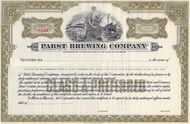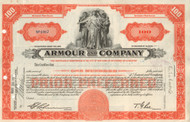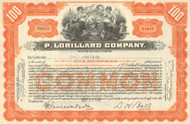Categories
Categories
- Home
- Automotive
- Automakers
- Willys-Overland Company (large format) 1930's
Willys-Overland Company (large format) 1930's
Product Description
Willys-Overland stock certificate (large format) 1930's
This rare stock cert is not often seen in the collectors market. The larger format (9.5" x 13.5") makes it a great display piece. Great vignette of angels flanking the company monogram logo. Colors inlcude blue and brown. Incorporated in Ohio. Issued and cancelled. Dates in the 1930's.
In 1911, the Electric Auto-Lite Company was organized. The company manufactured automobile lighting and ignition equipment, and later added battery and farm lighting divisions. The Electric Auto-Lite Company was acquired by John Willys in 1914 and he changed its name to the Willys Corporation in 1917. In 1919, the company acquired the entire capital stock of the New Process Gear Corporation of Syracuse, N.Y. and of the Dusenberg Motors Corporation. Willys Corporation was also a major shareholder in the Willys - Overland Company.
In 1908, John Willys bought the Overland Automotive Division of Standard Wheel Company and in 1912 renamed it Willys-Overland Motor Company. From 1912 to 1918, Willys was the second-largest producer of automobiles in the United States after Ford Motor Company. In 1913, Willys acquired a license to build the Charles Knight's sleeve-valve engine which it used in cars bearing the Willys-Knight nameplate. In the mid-1920s, Willys also acquired the F.B. Stearns Company of Cleveland and assumed continued production of the Stearns-Knight luxury car, as well.
John Willys acquired the Electric Auto-Lite Company in 1914 and in 1917 formed the Willys Corporation to act as his holding company. In 1916, it acquired the Russell Motor Car Company of Toronto, Ontario, by 1917 New Process Gear, and in 1919 acquired the Duesenberg Motors Company plant in Elizabeth, New Jersey. The New Jersey plant was replaced by a new, larger facility and was to be the site of production for a new Willys Six, but the 1920 recession brought the Willys Corporation to its knees. The bankers hired Walter P. Chrysler to sort out the mess and the first model to go was the Willys Six, deemed an engineering disaster. Chrysler had auto engineers Owen Skelton, Carl Breer, and Fred Zeder begin work on a new car, which was often referred to as the Chrysler Six.
To raise cash needed to pay off debts, many of the Willys Corporation assets were put on the auction block. The Elizabeth plant and the Chrysler Six prototype were sold to William C. Durant, then in the process of building a new, third empire. The plant built Durant's low-priced Star, while the Chrysler Six prototype was improved and modified, becoming the 1923 Flint.
Willys-Overland was one of several bidders when the War Department sought an automaker that could begin rapid production of a lightweight truck based on a design by American Bantam. In 1938, Joseph W. Frazer had joined Willys from Chrysler as chief executive. He saw a need to improve the firm's 4-cylinder engine to handle the punishment to which the Jeep would be subjected.
Production of the Willys MB, better known as Jeep, began in 1941, shared between Willys, Ford, and American Bantam. 8,598 units were produced that year, and 359,851 units were produced before the end of World War II. Willys-Overland ranked 48th among United States corporations in the value of World War II military production contracts. In total, 653,568 military Jeeps were manufactured.
In 1946, a year after the introduction of the CJ-2A, Willys produced the Willys "Jeep" Utility Wagon based on the same engine and transmission, with clear styling influence from the CJ-2A Jeep. The next year came a "Jeep" Utility Truck with four-wheel drive. In 1948, the wagon was available in four-wheel drive, making it the ancestor of all sport utility vehicles.
In 1953, Kaiser Motors purchased Willys-Overland and changed the company's name to Willys Motor Company. The same year, production of the Kaiser car was moved from Willow Run, Michigan, to the Willys plant at Toledo, Ohio. Although Jeep production was steady, sales of the Willys and Kaiser cars continued to fall. After the last Willys passenger car was built in 1955, Willys shipped the Aero's tooling to Brazil, where it was built from 1960 to 1962, almost unchanged. Brooks Stevens restyled the Aero for 1963, and it was built by Ford (which bought the Willys factory) until the 1970s. In America, the company changed its name in 1963 to Kaiser-Jeep Corporation; the Willys name disappeared thereafter.
Kaiser-Jeep was sold to American Motors Corporation (AMC) in 1970 when Kaiser Industries decided to leave the automobile business. After the sale, AMC used engines it had developed for its other cars in Jeep models to improve performance and standardize production and servicing. Renault purchased a major stake in AMC in 1979 and took over operation of the company, producing the CJ series until 1986.
Chrysler purchased AMC in 1987 after the CJ had already been replaced with the Jeep Wrangler (also known as the YJ and later TJ), which had little in common with the CJ series other than outward appearance. The Jeep marque, owned by DaimlerChrysler and later Fiat, produces Jeep vehicles at a new Toledo Complex.
 Loading... Please wait...
Loading... Please wait... 








